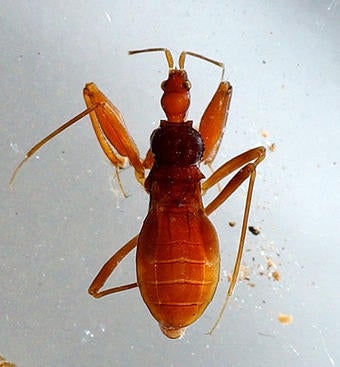Diagnosis and Specialized Morphology
Several diagnostic characters have been proposed for the Vesciinae. In the analysis of Weirauch (2008) these characters are homoplastic, have doubtful primary homology, or only support part of the group.
- Projection on the fore tibial apex (Costal Lima (1940): Vescia and Pessoaia; Wygodzinsky (1950): all genera; also used by Clayton (1990) as synapomorphy of Vesciinae). This character was not treated as primary homolog in Weirauch (2008) due to considerable differences in fine structure. The process in Pessoaia and Microvescia is blunt; the tibial comb is prominent and close to the tarsal insertion. In Vescia, Chopardita and Mirambulus the process is curved and pointed, the tibial comb is inconspicuous and removed from the tarsal insertion.
- Large anterior pronotal lobe (Fracker & Bruner (1924): Vescia) and short posterior lobe (Wygodzinsky (1950): all genera). A large and slightly bulbous anterior pronotal lobe is also observed in Peiratinae and some Saicinae/Emesinae. Proportion and shape of the anterior and the posterior pronotal lobes are rather different in Chopardita (e.g. posterior lobe trapezoidal) and Pessoaia (hind margin of posterior lobe rounded).
- Medial spine between the antennae (Fracker & Bruner (1924): Vescia). Only Vescia und Chopardita possess this frontal spine.
- The fore coxae are elongated (Costal Lima (1940): Vescia and Pessoaia; Wygodzinsky (1943): Vescia, Pessoaia, Microvescia). Elongated fore coxae also occur in Peiratinae and Saicinae/Emesinae.
- The ocelli are absent (Fracker & Bruner (1924): Vescia). This is true for Vescia, Chopardita, Pessoaia and Microvescia (Fig. 2a-c), but Mirambulus does posses ocelli (Wygodzinsky 1947).
Taxonomic History
The subfamily Vesciinae was established by Fracker & Bruner (1924) for the neotropical genus Vescia, described by Stål (1866) in Reduviinae. Stål (1866) emphasized a conspicuous projection of the fore tibial apex as generic character. Costa Lima (1940) included the neotropical genus Pessoaia in Vesciinae pointing to a tibial projection also in that taxon. Wygodzinsky (1943) described Microvescia from Brazil, which closely resembles Pessoaia. In 1944, Villiers described the afrotropical taxon Chopardita and Villiers (1948) and China & Usinger (1948)commented on the close affinity of Chopardita to the neotropical Vescia. A fifth genus, also neotropical, was described by Wygodzinsky (1947) as Megavescia and synonymized with Mirambulus Breddin, 1901, by Wygodzinsky (1950). According to Wygodzinsky (1950), several characters of this genus appeared to be intermediate between Chopardita/Vescia and Pessoaia/Microvescia. Vesciinae thus comprise at present 5 genera and 20 species. Forero (2006) provides records for several of the relatively rarely collected species.
Members of three genera, Mirambulus, Pessoaia, and Vescia, were included in Weirauch’s (2008) the cladistic analysis of Reduviidae. Mirambulus and Vescia are recovered as sister taxa, but Pessoaia is the sister taxon to a large clade comprising other taxa of Reduviinae, Peiratinae, Salyavatinae etc. thus rendering Vesciinae polyphyletic. Future analysis should focus on including a large sampling of Vesciinae to test this hypothesis.
Natural History/Biology
Mirambulus morio is found in secondary forests and on roadsides, but is rarely collected and Pessoaia limai is found in tropical dry forest and were collected in Malaise traps and at light (Forero 2006). Brachyptery may occur in females within the genus Vescia (Forero 2006).
References
China, W.E., Usinger, R.L. 1948. A new species of Chopardita Villiers from the Anglo-Egyptian Sudan with notes on the subfamily Vesciinae (Hemiptera-Reduviidae). Ann. Mag. Nat. Hist., London 1: 598-604.
Costa Lima, A. 1940. Novo hemiptero reduviideo da sub-familia Vesciinae. Arquivos de Zoologia do estado de Sâo Paulo 1: 485–490.
Forero, D. 2006. New records of Reduviidae (Hemiptera: Heteroptera) from Colombia and other Neotropical countries. Zootaxa 1107: 1-47.
Fracker, S.D., Bruner, S.C. 1924. Notes on some Neotropical Reduviidae. Ann. Ent. Soc. Amer. Columbus 17: 163-174.
Stal, C. 1866. Bidrag till Reduviidernas kaennedom. Oef. K. Vet. Ak. Foerh. 23: 235-302.
Weirauch, C. 2008. Cladistic analysis of Reduviidae (Heteroptera: Cimicomorpha) based on morphological characters. Systematic Entomology 33: 229-274.
Wygodzinsky, P. 1943. Contribuicao ac conhecimento da subfamilia Vesciinae (Hemiptera, Reduviidae). Rev. brasil. Biol., Rio de Janeiro 3: 203-223.
Wygodzinsky, P. 1947. Sobre um novo genero neotropico de Vesciinae com consideracoes sobre a subfamilia (Reduviidae, Hemiptera). Rev. Ent., Rio de Janeiro 18: 411-416.
Wygodzinsky, P. 1950. On the genus Mirambulus Breddin, 1901, with general notes on the subfamily Vesciinae (Reduviidae, Hemiptera). Ann. Mag. Nat. Hist., London 3: 265-268.

